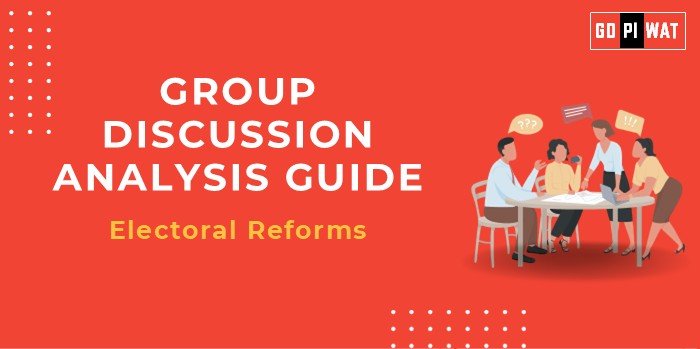📋 Group Discussion (GD) Analysis Guide: Electoral Reforms
🌐 Introduction
Opening Context: In democracies worldwide, public trust in electoral systems has significantly eroded, highlighted by declining voter turnout and increasing election-related misinformation. Electoral reforms could serve as a critical step to rebuild trust in democratic governance.
Topic Background: Electoral reforms aim to address issues of transparency, accessibility, and fairness in elections. Innovations like India’s Voter-Verified Paper Audit Trail (VVPAT) have demonstrated their transformative potential. However, challenges such as rising election costs and misinformation campaigns continue to undermine the effectiveness of reforms globally.
📊 Quick Facts & Key Statistics
- 📉 Voter Turnout Decline: Global voter turnout decreased from 68% (1990) to 62% (2022), reflecting waning faith in democratic processes.
- 📢 Misinformation Impact: In 2023, 58% of voters globally encountered fake news during elections, eroding trust.
- 🇮🇳 India’s Electoral Reforms: Introduction of VVPAT in 2013 reduced voting discrepancies by 95%.
- 💰 Election Costs: Conducting elections now costs $10 billion annually in democratic nations, a 40% rise over two decades.
🤝 Stakeholders and Their Roles
- 🏛️ Election Commissions: Implement reforms and ensure fair processes.
- 🏛️ Governments: Support electoral transparency and legislative changes.
- 📢 Civil Societies: Advocate for inclusivity and counter voter suppression.
- 🗳️ Citizens: Engage actively in elections to demand accountability.
- 💻 Technology Providers: Innovate secure voting technologies like blockchain systems.
📚 Achievements and Challenges
🏆 Achievements
- ✅ Technological Reforms: India’s VVPAT system ensures auditability and transparency.
- 🌟 Global Innovations: Estonia’s e-voting has increased convenience and trust.
- 🌍 Increased Representation: Electoral quotas have improved diversity in many legislatures.
⚠️ Challenges
- 📢 Misinformation Campaigns: Fake news undermines electoral integrity.
- 💰 Rising Costs: Election expenses strain resources in democratic nations.
- 🌐 Accessibility Gaps: Limited digital literacy and infrastructure in rural areas hinder reforms.
🌍 Global Comparisons
- ✅ Success: Estonia’s secure e-voting system.
- ❌ Failures: U.S. redistricting controversies and voter suppression issues.
💡 Effective Discussion Approaches
📜 Opening Approaches
- 📈 Highlight declining global voter turnout statistics.
- 🔍 Cite India’s VVPAT success as a technological breakthrough.
🔄 Counter-Argument Handling
- 📊 Acknowledge the high costs of reforms and propose digitalization as a cost-effective solution.
📊 Strategic Analysis of Strengths & Weaknesses
- 🌟 Strengths:
- Improved transparency.
- Technological advances in voting systems.
- ⚠️ Weaknesses:
- Rising costs.
- Low adoption of reforms in rural areas.
- ✨ Opportunities:
- Use of AI to counter misinformation.
- Global collaboration to address challenges.
- ⚡ Threats:
- Cybersecurity risks.
- Political resistance to change.
🗣️ Structured Arguments for Discussion
- 👍 Supporting Stance: “Electoral reforms are essential to restore trust, as seen with VVPAT reducing voting discrepancies by 95% in India.”
- 👎 Opposing Stance: “High costs and cybersecurity risks make comprehensive reforms challenging.”
- ⚖️ Balanced Perspective: “While reforms are critical, success depends on addressing systemic barriers like misinformation and infrastructure gaps.”
🎓 Connecting with B-School Applications
- 📘 Real-World Applications:
- Public policy projects on electoral financing and transparency.
- Strategy models for implementing reforms in developing nations.
- ❓ Sample Interview Questions:
- “How can technology enhance electoral integrity?”
- “What are the key challenges in scaling electoral reforms globally?”
- 📖 Insights for Students:
- Study the impact of reforms on voter trust.
- Explore how business innovations, such as blockchain, can improve electoral systems.


